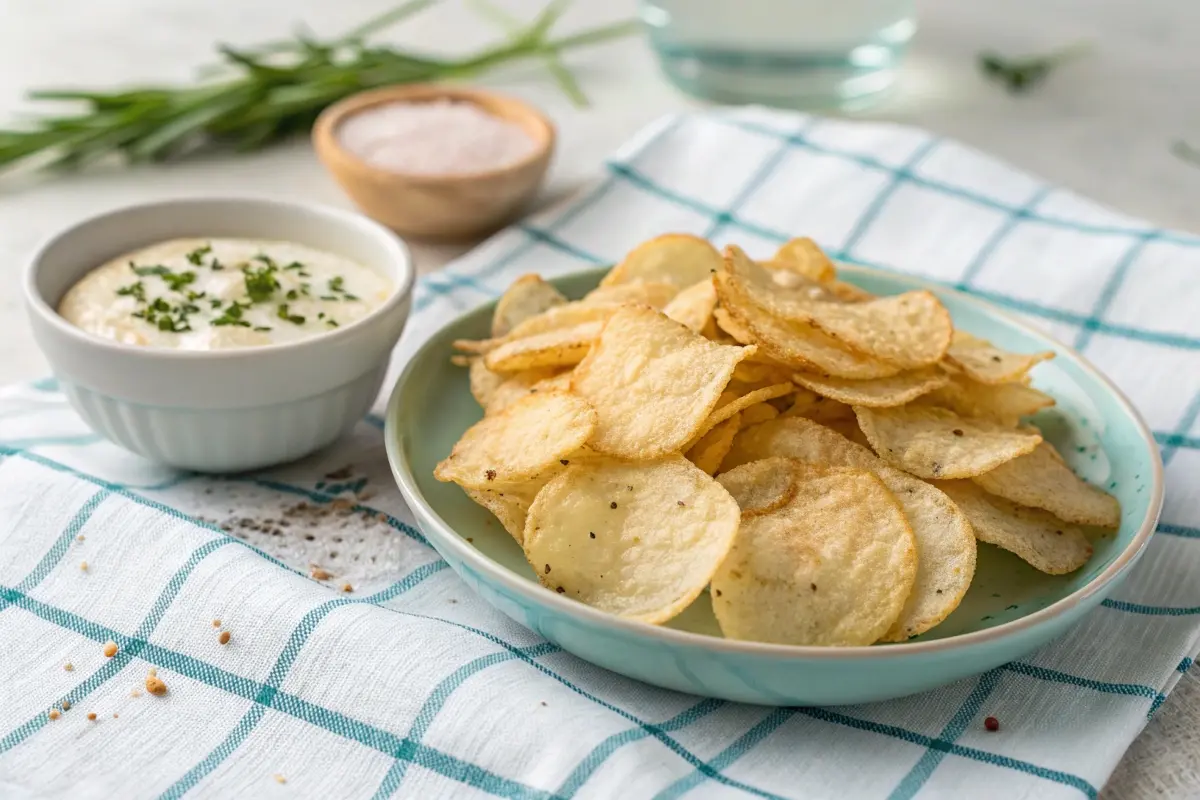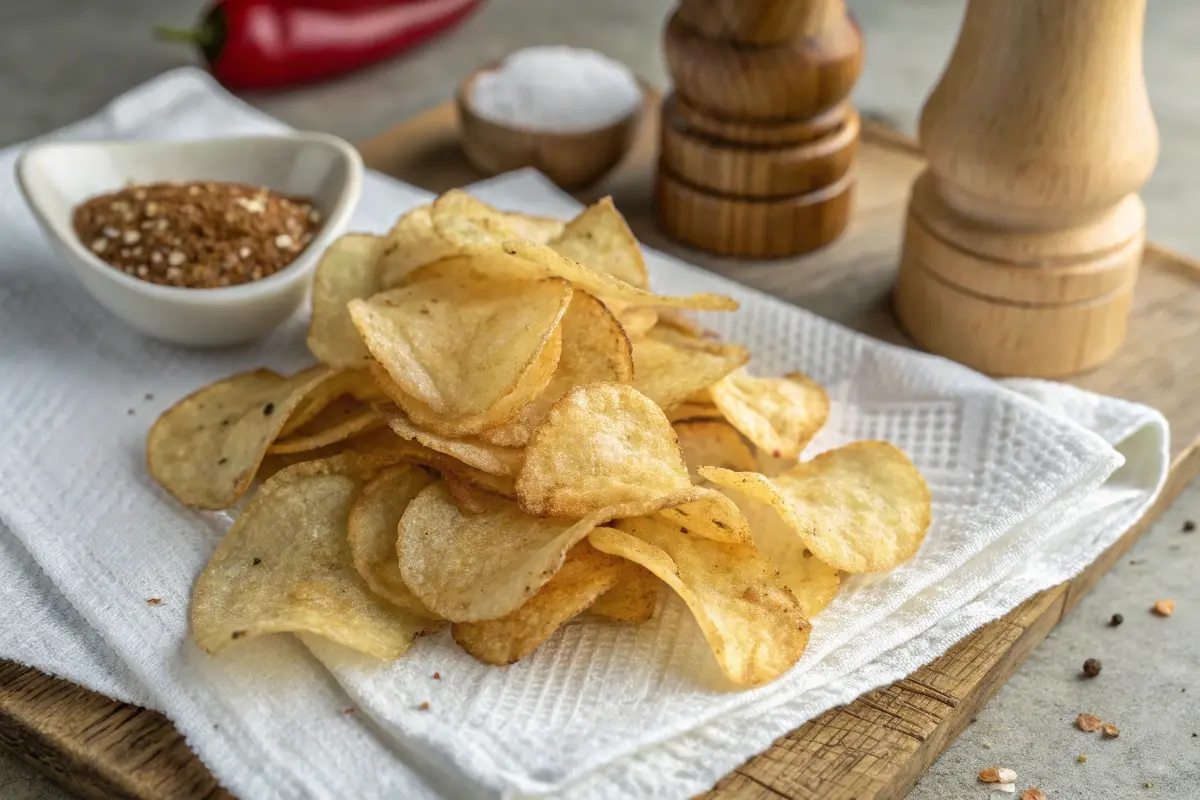Who doesn’t love the fiery crunch of spicy chips? They’re bold, flavorful, and can instantly liven up snack time. But is it OK to eat spicy chips regularly? That’s a question worth exploring. Like any indulgent snack, spicy chips have their upsides and downsides, and their effects depend largely on how much and how often you eat them.
This article dives into everything you need to know about spicy chips—from their nutritional breakdown to their impact on your health. Whether you’re a casual snacker or a spice fanatic, keep reading to find out if spicy chips deserve a place in your diet.

Introduction to Spicy Chips: Why Are They So Popular?
Spicy chips have an undeniable charm. For many, it’s the thrill of heat combined with the satisfying crunch that makes these snacks irresistible. Capsaicin, the compound found in chili peppers, is the secret ingredient behind the fiery flavor. It not only provides a kick but can also stimulate endorphins, leaving you with a brief “feel-good” sensation.
But there’s more to their popularity. Spicy chips are designed to be addictive, with just the right mix of salt, spice, and crunch to keep you reaching for “just one more.” From casual movie nights to social gatherings, they’ve become a staple snack in many households.
Nutritional Overview of Spicy Chips
Before deciding if spicy chips are OK to eat, let’s break down what’s in them. While the exact composition varies by brand, here’s an example of the typical nutritional content per serving (around 28 grams):
| Nutrient | Average Quantity per Serving |
|---|---|
| Calories | 150–180 |
| Total Fat | 10–12g |
| Saturated Fat | 1–2g |
| Sodium | 200–300mg |
| Carbohydrates | 15–18g |
| Protein | 1–2g |
In addition to these macronutrients, spicy chips often include artificial flavorings, preservatives, and spice blends. These added ingredients contribute to their taste but may raise concerns about excessive consumption.
Health Impacts of Eating Spicy Chips
Effects on Digestive Health
For those with sensitive stomachs, spicy chips can be a mixed bag. Capsaicin, the key ingredient that gives spicy chips their heat, can irritate the lining of the stomach when consumed in large quantities.
“Consuming spicy snacks excessively may lead to acid reflux, heartburn, or mild stomach upset, especially in individuals with pre-existing digestive issues.”
While occasional consumption is unlikely to cause harm, eating too many spicy chips in one sitting might leave you reaching for an antacid.
Risks of Overeating Spicy Chips
Spicy chips are high in calories, sodium, and fat, which can pose health risks if consumed excessively. Overeating these snacks may contribute to:
- Weight Gain: The calorie count adds up quickly if you’re not mindful of portion sizes.
- High Blood Pressure: The sodium content can be problematic, especially for individuals with hypertension.
- Skin Irritation: Believe it or not, the oils from spicy chips can even irritate your skin if you touch your face after eating!
Benefits of Capsaicin: The Star Ingredient in Spicy Chips
Not everything about spicy chips is negative. Capsaicin, the compound that provides their heat, has been linked to several potential health benefits:
- Boosts Metabolism: Capsaicin may temporarily increase your metabolic rate, helping you burn a few extra calories.
- Pain Relief: It’s used in topical creams for joint pain due to its numbing effect.
- Mood Enhancer: Eating spicy foods can trigger the release of endorphins, which improve your mood.
So, while spicy chips shouldn’t be your go-to health food, they’re not without their perks when enjoyed occasionally.
Can Spicy Chips Be Part of a Balanced Diet?
The good news is that you don’t have to give up spicy chips entirely. Like most indulgent snacks, they can fit into a balanced diet if you approach them with moderation and mindfulness. The key is to enjoy them occasionally rather than making them a daily habit.
Moderation Is Key
Eating spicy chips in controlled portions is crucial. Most bags of chips list a single serving as around 28 grams (or a handful), but let’s be honest—who stops at just one handful? If you struggle to limit your portions, consider purchasing single-serve bags to help control your intake.
To balance your diet, pair spicy chips with healthier options during meals or snacks. For example, add a handful of chips to a plate of fresh vegetables or serve them alongside a lean protein source like grilled chicken or a hard-boiled egg.
Alternatives to Conventional Spicy Chips
If you’re a fan of the spicy crunch but want healthier options, here are some alternatives:
- Baked Spicy Chips: Lower in fat and calories compared to fried varieties.
- Spicy Kale Chips: A nutrient-dense snack that offers crunch without the guilt.
- Homemade Spicy Chips: Control the ingredients by baking thin slices of sweet potatoes or zucchini with a sprinkle of chili powder.
- Spicy Air-Popped Popcorn: A lower-calorie option that satisfies the craving for spice.
By making smarter snack choices, you can enjoy the flavors you love while prioritizing your health.

Common Problems Linked to Spicy Chips Consumption
While spicy chips can be an enjoyable treat, excessive consumption may lead to a few unwanted side effects.
Heartburn and Acid Reflux Issues
For those prone to acid reflux or GERD (gastroesophageal reflux disease), spicy chips can be a trigger. The capsaicin in chili powder and other spices can irritate the esophagus, causing a burning sensation and discomfort.
To reduce the risk, avoid eating spicy chips on an empty stomach and drink plenty of water alongside them.
Allergic Reactions to Spices
Did you know that some people are allergic to the spices used in spicy chips? Common allergens include chili powder, paprika, and other flavoring agents. Symptoms may include:
- Skin rashes or itching
- Swelling of the lips or tongue
- Difficulty breathing in severe cases
If you suspect an allergy, it’s best to avoid spicy chips altogether and consult with a healthcare professional.
High Sodium Concerns
Spicy chips are notoriously high in sodium, with a single serving containing up to 300 milligrams or more. Consuming too much sodium over time can contribute to high blood pressure, kidney strain, and other health issues.
Tip: Pair spicy chips with low-sodium foods and limit other salty snacks throughout the day to keep your sodium intake in check.
Tips for Eating Spicy Chips Safely
Want to enjoy spicy chips without the guilt or discomfort? Follow these tips:
How to Minimize Digestive Discomfort
- Eat spicy chips with a meal instead of on their own to avoid overwhelming your digestive system.
- Pair them with dairy products like yogurt or milk, which can help neutralize the heat of capsaicin.
- Avoid consuming spicy chips late at night to prevent acid reflux while lying down.
Pairing Spicy Chips with Healthier Options
To make your snack more balanced, try these pairings:
- Hummus or Guacamole: The healthy fats in these dips can help offset the spice.
- Fresh Veggies: Crunchy celery or carrot sticks add fiber and nutrients to your snack.
- Low-Fat Cheese: A small portion of cheese adds protein and helps balance the meal.
These combinations not only improve the nutritional profile of your snack but also make it more satisfying.
Are Spicy Chips Safe for Kids?
Spicy chips are particularly popular among kids and teens, but are they safe for young digestive systems?
The Impact of Spicy Foods on Children’s Digestive Systems
Children may experience heightened sensitivity to spicy foods. Capsaicin can irritate their stomach lining and cause symptoms like stomachaches or diarrhea if consumed in large quantities.
To minimize risks, parents should limit the serving size and avoid letting kids eat spicy chips too frequently. Introducing milder snacks or homemade versions can be a safer option.
Creating Healthy Snacking Habits for Kids
Instead of banning spicy chips outright, teach kids about mindful eating. Encourage them to enjoy chips as an occasional treat rather than a daily staple. You can also involve them in making homemade spicy snacks using healthier ingredients.
Spicy Chips and Cultural Preferences
Spicy chips have gained global popularity, but their appeal varies across cultures.
Why Do Some Cultures Enjoy Spicy Snacks More?
In many cultures, spicy foods are a staple of the diet, making spicy chips a natural extension of their flavor preferences. Countries like Mexico, India, and Thailand, where spices are celebrated, have a higher demand for spicy snacks compared to other regions.
The Global Appeal of Spicy Chips
Brands have capitalized on the universal love for spice by creating regional flavors. For example, you might find “Szechuan Hot” chips in Asia or “Chili Lime” chips in Latin America. These flavor innovations reflect the diverse ways people enjoy spice around the world.
Homemade Recipe: Spicy Chips with a Twist
Want to control the ingredients and enjoy a healthier version of spicy chips? Making your own spicy chips at home is easier than you think. This recipe ensures you get all the flavor without the excessive fat, sodium, or artificial additives.
Ingredients:
- 2 large potatoes or sweet potatoes (thinly sliced)
- 2 tablespoons olive oil
- 1 teaspoon chili powder
- 1/2 teaspoon cayenne pepper (adjust to taste)
- 1/2 teaspoon smoked paprika
- 1/2 teaspoon garlic powder
- 1/4 teaspoon salt (or to taste)
Instructions:
- Preheat your oven to 375°F (190°C).
- Thinly slice the potatoes using a mandoline or sharp knife to ensure even cooking.
- In a large bowl, toss the potato slices with olive oil until they’re evenly coated.
- In a small bowl, mix the chili powder, cayenne pepper, smoked paprika, garlic powder, and salt. Sprinkle the spice mixture over the potatoes and toss well to coat.
- Arrange the potato slices in a single layer on a baking sheet lined with parchment paper. Avoid overlapping the slices to ensure they cook evenly.
- Bake for 15-20 minutes, flipping the slices halfway through, until they are crispy and golden brown.
- Let them cool slightly before serving. Pair with a yogurt-based dip to balance the heat or enjoy them as they are!
This homemade version is not only customizable but also free of preservatives and artificial ingredients. You can experiment with different spice blends, such as adding cumin for an earthy kick or lime zest for a tangy flavor twist.
Making your own spicy chips is a great way to enjoy the flavors you love while controlling portion sizes and nutritional content. Whether for a snack or a party appetizer, these chips are sure to be a hit!

Should You Be Eating Spicy Chips?
The verdict? It’s perfectly OK to eat spicy chips in moderation. They’re a flavorful treat that can fit into a balanced diet as long as you’re mindful of portion sizes and pair them with healthier options. However, if you experience discomfort or have specific health conditions, it’s best to limit your intake or explore alternative snacks.
As with all indulgences, the key is balance. Enjoy the fiery crunch, but don’t let it consume your diet—or your health!
FAQs About Spicy Chips
How to make any chip spicy?
It’s easy to turn plain chips into a spicy treat! Simply sprinkle your favorite spices like chili powder, cayenne pepper, or paprika onto the chips. For better adhesion, lightly mist the chips with olive oil or lime juice before adding the spices. Shake them in a bowl to coat evenly, and enjoy your homemade spicy snack!
Can spicy chips cause stomach pain?
Yes, eating too many spicy chips can irritate your stomach lining, leading to pain, bloating, or heartburn.
Are spicy chips bad for kids?
Spicy chips can be too harsh for young digestive systems. It’s best to offer them sparingly or explore milder alternatives.
Do spicy chips have any health benefits?
Capsaicin in spicy chips may boost metabolism and release endorphins, but the high fat and sodium content outweigh these benefits if eaten excessively.
What’s the best way to eat spicy chips without feeling discomfort?
Pair spicy chips with dairy, eat them with a meal, and avoid consuming them late at night to reduce digestive discomfort.
Are baked spicy chips healthier than fried ones?
Yes, baked versions are usually lower in fat and calories, making them a better choice.
Can spicy chips help with weight loss?
While capsaicin may slightly boost metabolism, the high calorie content of spicy chips makes them unsuitable for weight loss when eaten in large amounts.
